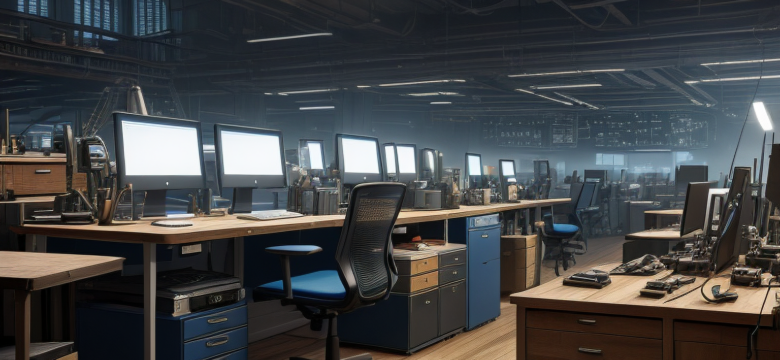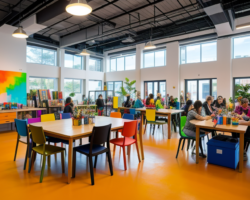In today’s fast-paced world, traditional teaching methods often fall flat, leaving participants disengaged and uninspired. Workshop experts have identified innovative techniques that can truly transform the learning experience. Imagine walking into a workshop where every participant is not just a passive listener but an active contributor, buzzing with ideas and enthusiasm. This is the magic of hands-on learning and collaboration.
These game-changing methods focus on active engagement, ensuring that participants do not just absorb information but also apply it practically. By incorporating techniques such as brainstorming sessions and feedback mechanisms, workshops can foster an environment where creativity flourishes and learning becomes a shared journey. For instance, consider the difference between merely listening to a lecture and being part of a lively group discussion where ideas bounce off one another like a game of ping-pong!
Moreover, integrating technology into workshops can elevate the experience even further. Tools like interactive platforms and virtual reality provide immersive environments that captivate participants, making learning not only effective but also enjoyable. When participants leave a workshop feeling energised and equipped with new skills, it’s clear that these methods are not just trends; they’re the future of effective learning.
Understanding the Importance of Hands-On Learning
Hands-on learning is not just a buzzword; it’s a game-changer in the realm of education and skill acquisition. Imagine trying to learn to ride a bike by just reading a manual—it’s nearly impossible, right? The same principle applies to workshops. Engaging in practical experiences allows participants to grasp concepts more effectively and retain information longer. Studies have shown that when learners actively participate, they are more likely to remember what they’ve learned.
In workshops, hands-on techniques can take many forms, such as:
- Simulations: These replicate real-life scenarios, enabling participants to practice skills in a controlled environment.
- Group Projects: Collaborating on tasks fosters teamwork while allowing individuals to apply their knowledge.
- Role-Playing: This method encourages participants to step into different shoes, enhancing empathy and understanding of various perspectives.
Moreover, hands-on learning promotes critical thinking and problem-solving skills. When faced with real-world challenges, participants must think on their feet, which is invaluable in both personal and professional settings. By immersing themselves in the learning process, they become active participants rather than passive recipients of information. So, the next time you’re in a workshop, remember that getting your hands dirty might just be the best way to learn!
Collaborative Techniques That Foster Teamwork
In today’s fast-paced world, collaboration is more than just a buzzword; it’s a vital ingredient for success in workshops. When participants come together, sharing ideas and solving problems, the synergy created can lead to innovative solutions that no one could achieve alone. Imagine a group of minds, each bringing their unique perspective to the table—it’s like a vibrant tapestry of creativity and insight!
One of the most effective ways to foster this teamwork is through interactive group activities. These activities not only break the ice but also encourage participants to engage deeply with one another. For instance, consider using techniques like peer teaching, where participants take turns sharing knowledge on specific topics. This not only reinforces their understanding but also builds confidence and camaraderie among the group.
Additionally, incorporating team-building exercises can significantly enhance collaboration. Activities such as problem-solving challenges or creative brainstorming sessions can help participants learn to communicate effectively and appreciate diverse viewpoints. By embracing these collaborative techniques, workshops can transform into dynamic environments where teamwork thrives, leading to outstanding results.
Brainstorming Sessions: Unlocking Creativity
Brainstorming sessions are like a spark that ignites the flame of creativity within a group. When participants gather to share their thoughts, it’s akin to a symphony where each idea plays its part, creating a harmonious blend of innovation. But how do we ensure these sessions are truly effective? Well, it’s all about creating the right environment and utilising the right techniques.
Firstly, consider the atmosphere. A relaxed and open setting encourages participants to express their ideas without fear of judgment. This is where structured brainstorming comes into play. By setting clear guidelines and objectives, you can channel the group’s energy into productive discussions. On the other hand, unstructured brainstorming allows for free-flowing ideas, which can lead to unexpected and revolutionary concepts. Knowing when to employ each method is crucial for maximising creativity.
Moreover, incorporating visual aids can significantly enhance the brainstorming process. Visuals not only clarify complex ideas but also stimulate discussion and engagement. Think of it this way: a picture is worth a thousand words, and in a brainstorming session, that picture can be the catalyst for a groundbreaking idea. Whether it’s through mind maps, sketches, or digital tools, visuals can transform the mundane into the extraordinary.
In conclusion, effective brainstorming sessions are about more than just generating ideas; they’re about unlocking the creative potential of each participant. By fostering an inclusive environment, choosing the right structure, and utilising visuals, you can turn a simple gathering into a powerhouse of innovation.
Structured vs. Unstructured Brainstorming
When it comes to brainstorming, the debate between structured and unstructured approaches can be quite enlightening. Both methods have their unique strengths, and understanding these can be the key to unlocking creativity in workshops. Imagine structured brainstorming as a well-organised train journey, where every stop is planned, and every passenger knows their destination. This method typically involves set rules, time limits, and specific goals, making it easier to focus on generating relevant ideas. For instance, participants might use a mind mapping technique to visually organise thoughts, which can lead to clearer outcomes.
On the other hand, unstructured brainstorming is like a spontaneous road trip, where participants explore ideas freely without predefined paths. This approach encourages creativity to flow without restrictions, allowing participants to build on each other’s thoughts organically. It can lead to unexpected and innovative ideas, but it may also result in a lack of focus. When should you use each? Here’s a quick comparison:
| Aspect | Structured Brainstorming | Unstructured Brainstorming |
|---|---|---|
| Focus | Goal-oriented | Open-ended |
| Outcome | Clear and actionable | Innovative but may lack direction |
| Time Management | Time-bound | Flexible |
Ultimately, the choice between structured and unstructured brainstorming depends on the workshop’s objectives. Mixing both methods can often yield the best results, allowing for a balance of creativity and direction. So, why not experiment with both styles in your next workshop and see which sparks the most innovative ideas?
Utilising Visual Aids in Brainstorming
When it comes to brainstorming, visual aids can be the secret sauce that elevates the entire process. Imagine trying to piece together a puzzle without seeing the picture on the box; it’s daunting, right? Similarly, in brainstorming sessions, visuals act as a roadmap, guiding participants through the maze of ideas. By incorporating charts, diagrams, and images, you can transform abstract concepts into tangible insights that everyone can grasp.
One effective way to utilise visual aids is through mind mapping. This technique allows participants to visually organise their thoughts, making connections between ideas that might otherwise remain hidden. Not only does it enhance understanding, but it also sparks creativity as participants see how their ideas interlink. For instance, a mind map can start with a central theme and branch out into various subtopics, each represented visually, making it easier to explore and expand upon.
Additionally, consider using whiteboards or digital platforms where participants can collaboratively draw and annotate in real-time. This interactive approach not only keeps everyone engaged but also allows for immediate visual feedback. As ideas evolve, so do the visuals, creating a dynamic environment where creativity can flourish. So, the next time you’re leading a brainstorming session, remember that a picture is worth a thousand words—utilise those visual aids to unlock new levels of innovation!
Feedback Mechanisms That Enhance Learning
Feedback is the secret sauce that can elevate the learning experience in workshops. It’s not just about giving praise or criticism; it’s about creating a dynamic dialogue between participants and facilitators. This ongoing conversation helps individuals identify their strengths and areas for improvement, fostering a culture of growth. But how can workshop leaders effectively implement feedback mechanisms?
One effective approach is to use structured feedback sessions. These sessions can be scheduled at various points throughout the workshop, allowing participants to reflect on what they’ve learned and how they can apply it. Additionally, incorporating peer feedback can be incredibly valuable. When participants share insights with one another, it not only builds camaraderie but also encourages diverse perspectives. Imagine a scenario where a group of attendees reviews each other’s work; the insights gained can be transformative!
Another innovative method is to utilise digital feedback tools. Platforms like Google Forms or Mentimeter allow for real-time feedback collection, making it easy for participants to share their thoughts anonymously. This can lead to more honest responses and a better understanding of the workshop’s impact. Here’s a quick look at some effective feedback mechanisms:
| Feedback Mechanism | Description |
|---|---|
| Structured Feedback Sessions | Scheduled intervals for participants to reflect and share insights. |
| Peer Feedback | Participants review each other’s work, promoting collaboration. |
| Digital Feedback Tools | Real-time collection of feedback via online platforms. |
In conclusion, effective feedback mechanisms not only enhance learning but also create a more engaging and interactive workshop environment. By embracing these strategies, facilitators can ensure that every participant leaves with valuable insights and a sense of accomplishment.
Integrating Technology for Enhanced Engagement
In today’s fast-paced world, technology has become an essential ingredient in the recipe for successful workshops. The integration of various tech tools not only enhances the learning experience but also keeps participants engaged and motivated. Imagine a workshop where participants can interact with content in real-time, share ideas seamlessly, and collaborate effortlessly. Sounds exciting, right? Well, that’s the power of technology!
One of the standout features of modern workshops is the use of interactive tools. These platforms allow participants to engage with the material and each other in ways that traditional methods simply cannot match. For instance, tools like Miro and Mentimeter facilitate brainstorming sessions, enabling participants to contribute ideas on a digital canvas or vote on suggestions instantly. This not only fosters a sense of community but also promotes a more dynamic learning atmosphere.
Moreover, the advent of Virtual Reality (VR) has revolutionised how workshops are conducted. Imagine stepping into a virtual environment where you can interact with 3D models or simulated scenarios. This immersive experience can significantly enhance understanding and retention of complex concepts. For example, a workshop on architecture could allow participants to explore buildings in a virtual space, making learning not just informative but also thrilling.
As we embrace these technological advancements, it’s crucial to remember that the goal is to enhance engagement and facilitate learning. The right blend of traditional and modern techniques can create a workshop environment that is not only effective but also memorable.
Utilising Interactive Tools and Platforms
In today’s fast-paced world, interactive tools and platforms are revolutionising the way we conduct workshops. Imagine walking into a room where technology seamlessly integrates with learning, making every participant feel engaged and valued. These tools not only facilitate collaboration but also encourage creativity and innovation among attendees.
For instance, platforms like Miro and Zoom allow participants to brainstorm ideas in real-time, regardless of their physical location. This means that whether you’re in a bustling city or a quiet countryside, you can contribute equally to the discussion. The beauty of these tools lies in their ability to break down geographical barriers, fostering a sense of community and teamwork.
Moreover, incorporating gamification elements into workshops can significantly boost motivation. By turning learning into a game, participants are more likely to engage with the material. Consider using tools that offer quizzes, polls, or interactive simulations; these can transform a mundane session into an exciting challenge.
In summary, the integration of interactive tools not only enhances engagement but also creates a dynamic learning environment. As workshop leaders, embracing these platforms can lead to more productive sessions where participants leave feeling inspired and equipped with new skills.
Leveraging Virtual Reality in Workshops
Imagine stepping into a world where learning transcends traditional boundaries. Virtual Reality (VR) is revolutionising workshops by offering immersive experiences that captivate participants like never before. Instead of merely listening to a lecture, attendees can engage in a three-dimensional environment that simulates real-world scenarios. This not only enhances understanding but also makes the learning process exciting and memorable.
One of the most significant advantages of VR in workshops is its ability to create a safe space for experimentation. Participants can practice skills and make mistakes without real-world consequences, leading to deeper learning. For instance, a workshop on emergency response can utilise VR to simulate crisis situations, allowing learners to develop their decision-making skills under pressure.
Moreover, VR can cater to various learning styles, appealing to visual and kinesthetic learners. By incorporating interactive elements, such as 3D models and simulations, participants are more likely to retain information. This type of engagement not only boosts confidence but also fosters a sense of collaboration, as participants can explore and solve problems together in a virtual setting.
In conclusion, leveraging VR in workshops is not just about adopting new technology; it’s about transforming the learning experience into something truly extraordinary. As we continue to explore the possibilities of VR, the future of workshops looks bright and full of potential.
Frequently Asked Questions
- What are the benefits of hands-on learning in workshops?
Hands-on learning allows participants to actively engage with the material, enhancing understanding and retention. It’s like learning to ride a bike; you can read all about it, but you only truly master it once you get on and pedal!
- How do collaborative techniques improve teamwork?
Collaborative techniques create an environment where participants can share ideas and solve problems together. Think of it as a potluck dinner; everyone brings something to the table, resulting in a richer experience for all!
- What is the difference between structured and unstructured brainstorming?
Structured brainstorming follows a specific format to guide discussions, while unstructured brainstorming allows free-flowing ideas. Both have their place; structured is great for focus, whereas unstructured can lead to unexpected creativity!
- How can technology enhance workshop engagement?
Integrating technology like interactive tools and virtual reality can make workshops more dynamic and engaging. Imagine stepping into a virtual world where learning feels like an adventure rather than a chore!





